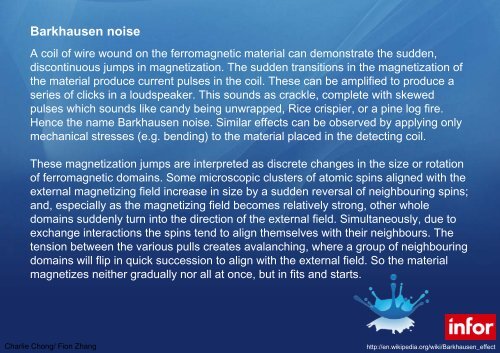Electromagnetic testing emt-mft chapter 9b
Electromagnetic testing emt-mft chapter 9b
Electromagnetic testing emt-mft chapter 9b
You also want an ePaper? Increase the reach of your titles
YUMPU automatically turns print PDFs into web optimized ePapers that Google loves.
Barkhausen noise<br />
A coil of wire wound on the ferromagnetic material can demonstrate the sudden,<br />
discontinuous jumps in magnetization. The sudden transitions in the magnetization of<br />
the material produce current pulses in the coil. These can be amplified to produce a<br />
series of clicks in a loudspeaker. This sounds as crackle, complete with skewed<br />
pulses which sounds like candy being unwrapped, Rice crispier, or a pine log fire.<br />
Hence the name Barkhausen noise. Similar effects can be observed by applying only<br />
mechanical stresses (e.g. bending) to the material placed in the detecting coil.<br />
These magnetization jumps are interpreted as discrete changes in the size or rotation<br />
of ferromagnetic domains. Some microscopic clusters of atomic spins aligned with the<br />
external magnetizing field increase in size by a sudden reversal of neighbouring spins;<br />
and, especially as the magnetizing field becomes relatively strong, other whole<br />
domains suddenly turn into the direction of the external field. Simultaneously, due to<br />
exchange interactions the spins tend to align themselves with their neighbours. The<br />
tension between the various pulls creates avalanching, where a group of neighbouring<br />
domains will flip in quick succession to align with the external field. So the material<br />
magnetizes neither gradually nor all at once, but in fits and starts.<br />
Charlie Chong/ Fion Zhang<br />
http://en.wikipedia.org/wiki/Barkhausen_effect


















